

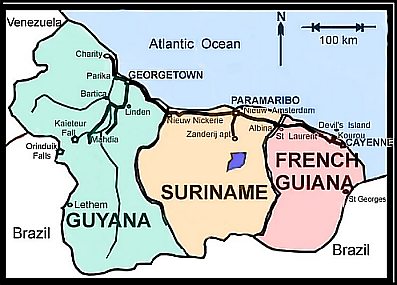 During colonial days there were three Guyanas: Dutch, British and French. Now two of them are independent, third one act as department of France. They lie in the region of tropical forests, huge rivers and savannas. Limited amount of tourists is visiting this area - it is still travel well off the beaten track. Infrastructure and transportation are lousy: Main roads are built along the coast, few roads heading to the interior are in bad condition. Rivers offer alternative access to the interior, but connections are not scheduled (except those to Bartica) and mostly based on a charter - you are always forced to form the group wishing to keep the cost low. Small turbo-prop planes are another alternative means of transport but rather expensive. Airfields except in capital cities are too small for jet airplanes. |
|
FRENCH GUIANA Since it is treated as a part of France there are inexpensive flights from Paris to Cayenne: 290 USD each way with AOM Minerve. It is probably at the moment the last expensive way from Europe to South America, especially interesting if you do not plan to fly back to Europe the same way. From Guyane you can enter Brazil via Saint Georges de l’Oyapock but so far they didn’t finish the road from the capital to Saint Georges: to get there you must take domestic flight (300 FRF one way) or a boat sailing once per month. On arrival to Cayenne airport nobody asked me to show onward ticket. Cayenne is disappointing. I expected to see well-developed capital of the province. In fact it is small, provincial town. But there are few places worth to see: view of the town and the river from the top of the hill with remains of Fort Ceperou. There is nice city hall and interesting colonial administrative buildings around Herder Square. On Place des Palmistes - full of distinguished palm trees there are food stalls in the evening. City museum nearby is also worth to see. They charge 15 FRF for the entry and you can see there butterfly collection, some Amerindian artifacts and paintings showing scenes from the penal colony era. Kourou: In the morning it is easy to catch “taxi colectiff” to Kourou from Rive Droite - it costs 50 FRF. Kourou itself is divided into two distant and different parts: new one consists of dozens of new villas inhabited by French working at the Space Center. There are organized tours to Space Center, but weekdays only. You will be probably interested to see the old village - located at the mouth of the river with some Caribbean-style houses and jetty on the river. Boats to Iles du Salut are sailing from here every morning at 8.30. They charge 190 FRF for round-trip voyage to Ile Royale. (Return at 5 pm), sea is usually rough. |
|
Devil’s Island: after one-hour sail by motorized catamaran you will land on Ile Royale. There are three islands one by one separated only by 200-meters wide, rough channels: Royal, the largest - in the middle, St Joseph with small beach (there is landing place - local boat can take you there) and Devil’s Island on the left where they kept political prisoners in the past. Devil’s Island is inaccessible due to rocky shores, currents and rough sea. That’s why they used primitive cableway over the channel to provide all supplies. So in fact tourist can see Devil’s Island from the distance of 200 meters only. |
|
| On the Ile Royale once they kept up to 2000 crime prisoners. There are remains of barracks, chapel, lighthouse and prison hospital. In the former guard’s mess they have restaurant and hotel (charging 300 FRF per night) and small gift shop. Backpackers can sling hammocks in former barrack paying 60 FRF. There is convenient path along the coast heading around the island - it takes about 45 minutes to make complete circle. | |
Saint Laurent du Maroni: There is only one bus per day from Cayenne to St Laurent via Kourou at 5 am. But it does not operate on weekends. I went there from Kourou by hitchhiking - the road is excellent but traffic, especially in the afternoons is weak. Hotel Star in Saint Laurent offers probably the cheapest accommodation - 180 FRF for single with a/c and shower. The main attraction of the town is abandoned Camp de la Transportation - where French kept prisoners on arrival from France -before sending them to different penal colonies. |
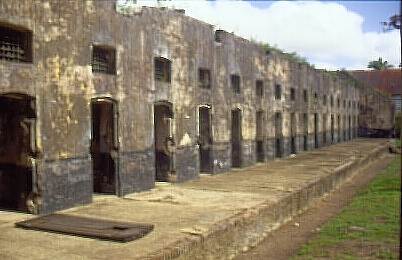 |
Main gate to the camp is open day and night. But if you want to see cells and shackles in the “Reclusion quarter” hidden behind high wall you need to join foot excursion departing from tourist office - just 100 m from the main gate of the camp, on the riverside. They charge 15 FRF. It is possible to rent dugout (16 meters long, capacity: 12) and to visit different places along the Maroni River - for half day they charge 150 FRF per person (minimum 4) and for full day 240 FRF (minimum 5). |
|
| SURINAME | |
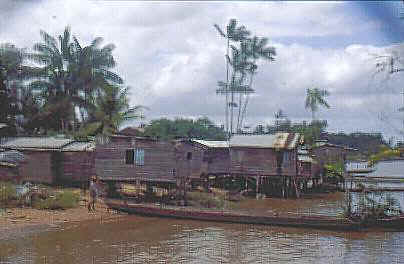 |
Visas are expensive: I arranged my visa in one day in Amsterdam - they charged 75 NGL for single entry visa. On arrival in Albina nobody asked me to exchange money. I got one-week permit that can be extended in the capital. Country is poor and dirty. Albina - tiny border village, there is really no reason to stop there unless you plan to take a dugout to Galibi Indian Reserve. Frequent minibuses depart when full from the immigration post at the jetty to capital city of Paramaribo. They charge 2000 SRG (about 5 USD) for the trip. Minibuses are tight - do not sleep there unless you can loose your possessions. |
In Paramaribo you can find dozens of colonial houses but many of them are run-down. I stayed in Fanna Guesthouse, Prinsessestraat 31 - it is friendly and safe place and they charge only 6 USD for basic single room (no fan, no bath attached). All tourist-oriented institutions accept payments in USD, so there is no reason to change lot of money. In Paramaribo unexpectedly there is couple nice buildings: Presidential Palace, mosque, synagogue, Fort Zelandia now is open Tue-Sun but mornings only on weekends. |
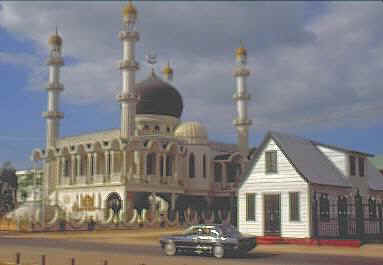 |
Imposing wooden cathedral of St Peter and Paul is closed for restoration. At the moment they also restore few nice colonial houses around the fort planing to establish there souvenir shops and other tourist-dedicated institutions. From Paramaribo you can take an excursion to Nieuw Amsterdam (public bus for USD 0,25 to Leonsberg on Suriname River and then boat for 1 USD) but the fortress and church there are in poor condition, and I do not recommend this tour. |
|
| Tourist agencies offer day trips to the interior, charging 50 USD per person (lunch and refreshments inclusive). The most popular will take you by minibus to Saramacca River and then after about 1-hour trip by boat you will reach village Santigron inhabited by Bush Negros. They perform for tourist some music and dancing, there is also a chance to see woodcarvings. In the village there is cottage with hammocks where you can spend a night. | |
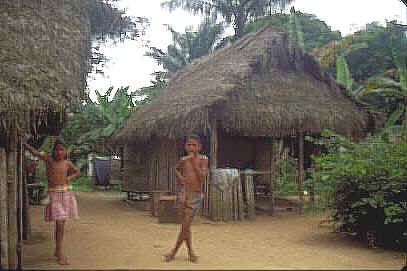 |
If you have just a day, limited budget and want to see countryside take a public bus from ferry terminal to Benharddorp (75 SRG). It is the country: and you have there a chance to see how the people live, what do they grow and what do they eat. During the day you can go to the distant (45 km) airport by yellow public bus - it will cost you 200 SRG (USD 0,50) but for early departures everybody is calling minibus (3000 SRG) - they will take you from the hotel. |
| GUYANA
There were no money exchange facilities in the airport but there was announcement at the exit, that minibus fare to the town is 500 GYD. (1 USD=142 GYD). If you will arrive at the day time and not in a hurry you can find local minibus no. 42 for 120 GYD. Georgetown is nicest of three Guyana capital cities. There are pretty colonial houses along the Main street, Disneyland-like City Hall and St George Cathedral to see. Promenade Gardens in the city center are small but full of flowers. Botanical gardens are on the outskirts of the town, run-down but still worth to see. Entry is free. Georgetown Tourist Office is now located at the corner of Camp and South Road. |
|
I stayed in centrally located Rima Guest House. It is clean, safe and worth to recommend. They provide mosquito nets, fan and towels. Rate for bed in double or triple room with communal bath is 10 USD. They can keep your luggage stored if you are going to the interior. City minibuses have their terminal in front of Starbroek Market. Local people cautioned me against muggers in the market area so I did not go in. There is alternative place to buy fruits and grocery: much safer open-air Bourda Market. Guyana is probably the cheapest place to buy the rum – big bottle costs around 2,5 USD. |
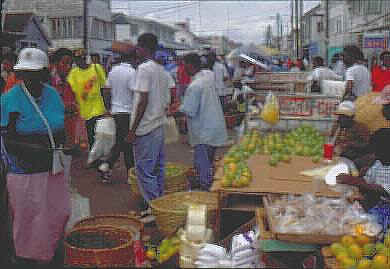 |
|
Both, local people and expatriates
enjoy the rum, but rum is not the main attraction of Guyana. Kaieteur Fall is principal tourist attraction of Guyana. It is one of most impressive waterfalls in the world. Single drop, 250 meters high and 80 to 120 meters wide depending on season. Angel is four times higher but not as wide as Kaieteur. The fall is hidden in the jungle, far from human settlements and land access is very difficult. Tour agencies in Georgetown like Shell Beach Adventures organize 4-days overland expeditions to the fall. It is real adventure; be prepared for heat, humidity and fighting with mosquitoes... Typical program looks like that: |
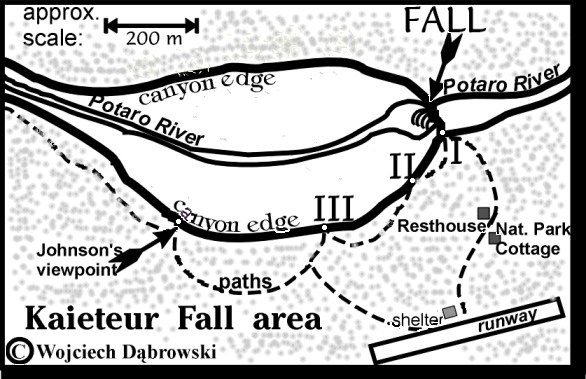 |
|
| Day one: truck to Meckdeci Camp. Day two: truck to Kangaruma. Day three: boat to Amatuk, then 3 hours hike and second boat to Tukiet. After that you have to climb 3 hours to the edge of the canyon. On the day four return by air to Georgetown. Typical price for that tour is 640 USD per person, although if you decide to take budget version it could be 480 USD. They provide transportation, food and hammock. Season starts in February. For lonely traveler there is extra problem: you must wait for the party of 3 or more... | |
| I was alone and forced to fly to the fall by small plane from Georgetown Ogle airport (15 min from city center). They charge 160 USD for circle flight GEO-Kaieteur-Orinduik-GEO inclusive National Park entry fee .Flight over the lush green, carpet-like jungle is very impressive. There is only small thatched shelter at the Kaieteur airstrip. Flight takes 1 hour 10 minutes. Before landing there is wonderful aerial view of the fall - keep you camera ready. Runway is paved. After 10 minutes walk you will reach small Government resthouse. There is kitchen and common room that can accommodate around 20 people. After another 10 minutes you will come to the canyon rim just at the fall. View is magnificent, but in early morning it was misty there so it is worth to wait an hour or so for better pictures. Then you have three another viewpoints to visit. They are located on the edge of the canyon and marked II, III and Johnson on my map. | |
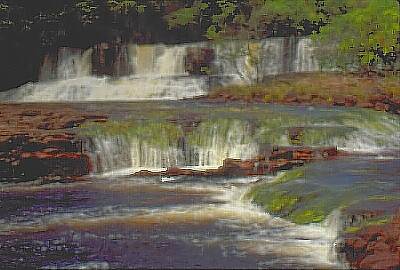 |
After about two hours we continued our flight to spectacular Orinduik Falls on the Ireng River, which form the border with Brazil. The river crosses the savanna. Falls are much lower - only 10 to 20 meters high, but very picturesque. It is possible to swim in the natural pool below the fall. Take your mosquito repellent with you! Direct return flight to GEO takes 1,5 hour. |
Bartica is small and safe town on the conjunction of Mazuruni and Essequibo rivers- worth to see. Going there you must take from Georgetown minibus no. 34 to Parika. (140 GYD). On the way you will cross pontoon bridge on Demerara river - longest in the world (about 2 km). From Parika there is ferry to Bartica three times a week, early morning (210 GYD - 5 hours). There are also speedboats waiting always (700 GYD -5 quarters). It is better to take ferry on the way back (at 6 am - sharp) when it works as banana boat - taking load of fruits and vegetables from riverside villages. In Bartica we stay there at very basic Pink House. It is inexpensive but primitive (no fan, no running water, no nets). They charge 200 GYD per bed. There is small market - worth to stroll around in the morning – later on only few stalls are open. It is possible to make trips by speedboat from Bartica: For 3000 GYD per boat they will take you to Kyk-over-al., for 7000 GYD to Marshall Falls, for 8000 GYD to both of them. Remains of Kyk-over-al lie on small river island some 15 minutes from Bartica by boat. They will take you there, but there is nothing to see except one archway made of brick and huge mango tree. And it is not worth 20 USD per boat charged for the trip. There is 1500 GYD tax on departure from Georgetown airport. Wojciech D±browski© |
|